Prepare to amaze your friends and family with these truly magnificent Red Velvet French Macarons. These exquisite pastries don’t just look like they came from a high-end Parisian patisserie; they taste exactly like a slice of indulgent red velvet cake, all thanks to their rich and tangy cream cheese filling. Achieving that coveted crisp shell and delightfully chewy interior has never been easier with this straightforward recipe, proving that professional-quality macarons are well within your reach right in your own kitchen.
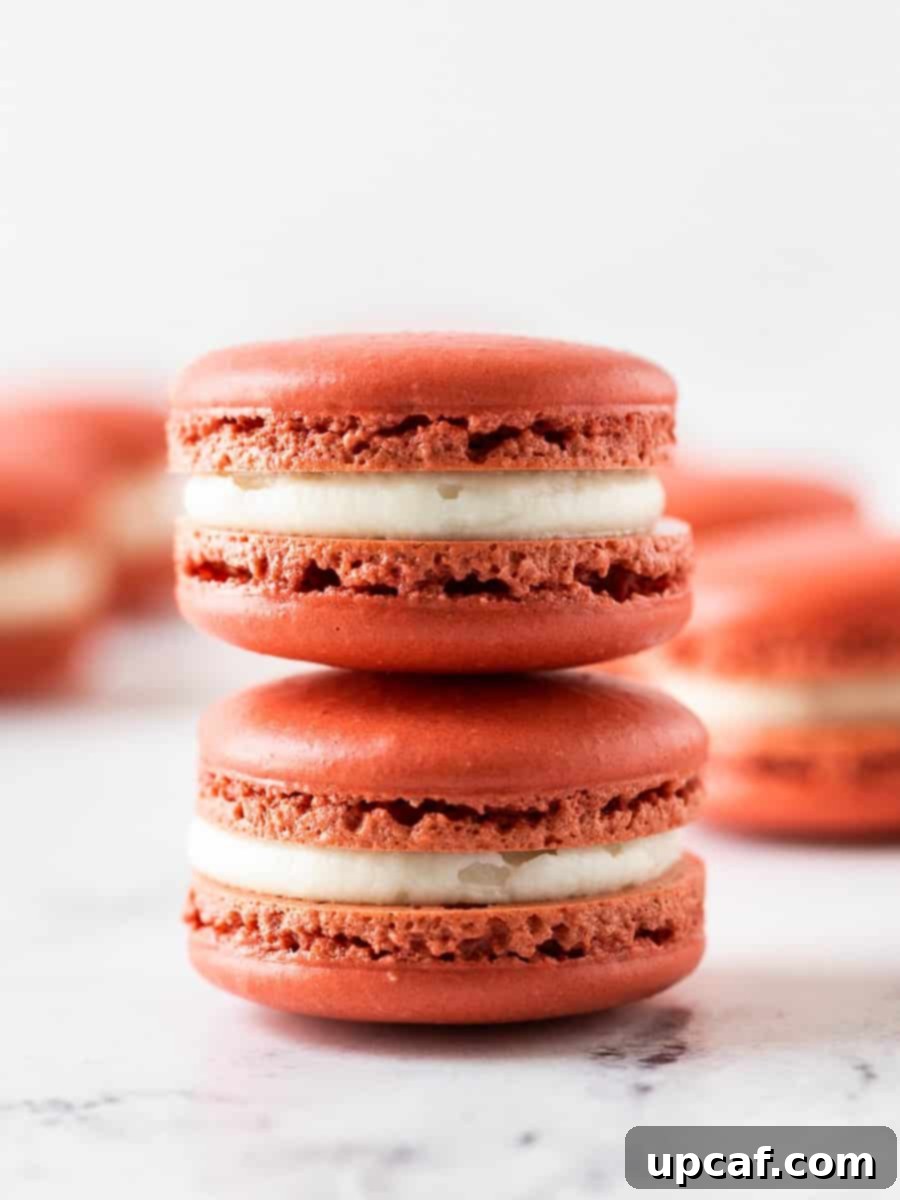
Each delicate bite of these red velvet macarons offers a harmonious blend of textures and flavors. The initial crispness of the shell gives way to a soft, melt-in-your-mouth center, perfectly complementing the creamy, sweet, and slightly tart filling. While the art of making homemade macarons might seem intimidating at first glance, this recipe breaks down every step into an approachable process. You’ll soon discover that baking these stunning red velvet inspired treats is not only incredibly rewarding but also so satisfying that you’ll never consider buying them from a store again!
If you’re eager to explore more delightful macaron flavors, I have a few other recipes that are equally easy to master and burst with incredible taste! Be sure to check out my Lemon Macarons for a zesty twist or my Strawberry Macarons for a sweet, fruity sensation. Both recipes promise the same perfect balance of crispness and chewiness, ensuring a delightful baking experience and delicious results.
Why You’ll Adore This Red Velvet Macaron Recipe
Crafting these Red Velvet French Macarons at home offers an array of benefits beyond just their incredible taste and visual appeal. Here’s why this recipe will quickly become a cherished favorite in your baking repertoire:
- Economical Indulgence: Forget the hefty price tag of gourmet bakeries. You only need a handful of readily available ingredients to create these impressive macarons. Making them from scratch allows you to enjoy a luxurious dessert without breaking the bank, transforming an expensive treat into an affordable pleasure right in your own kitchen.
- Irresistibly Delicious: These aren’t just pretty cookies; they are a true flavor experience. The carefully balanced cream cheese filling perfectly mimics the iconic taste of a classic red velvet cake, creating a macaron that is rich, subtly tangy, and utterly addictive. Each macaron shell is baked to achieve that signature delicate crispness on the outside, giving way to a wonderfully chewy interior, a texture sought after by macaron connoisseurs worldwide.
- Conveniently Freezer-Friendly: Life gets busy, but your craving for homemade macarons doesn’t have to wait. This recipe allows you to freeze the macaron shells for future enjoyment, making it ideal for advance meal preparation or having a delightful treat ready at a moment’s notice. Simply bake a larger batch, store the shells, and assemble with fresh filling whenever inspiration strikes. It’s a fantastic way to save time without compromising on quality or flavor.
- A Culinary Masterpiece You Can Create: There’s immense satisfaction in presenting a dessert that looks professionally made. These Red Velvet French Macarons are guaranteed to be a showstopper, impressing anyone who tastes or even just sees them. They look intricate and sophisticated, but this recipe makes the process surprisingly approachable, allowing you to confidently create a dessert that will earn you rave reviews.
- Perfect for Any Occasion: Whether it’s a special celebration, a thoughtful gift, or simply a desire for a luxurious afternoon tea treat, these red velvet macarons fit every scenario. Their elegant appearance and delightful taste make them suitable for everything from elaborate parties to quiet moments of self-indulgence.
Essential Red Velvet Macaron Ingredients
Creating perfect macarons requires precise measurements and high-quality ingredients. Each component plays a vital role in achieving the iconic texture, vibrant color, and exquisite flavor of these Red Velvet French Macarons. Here’s a detailed look at what you’ll need:
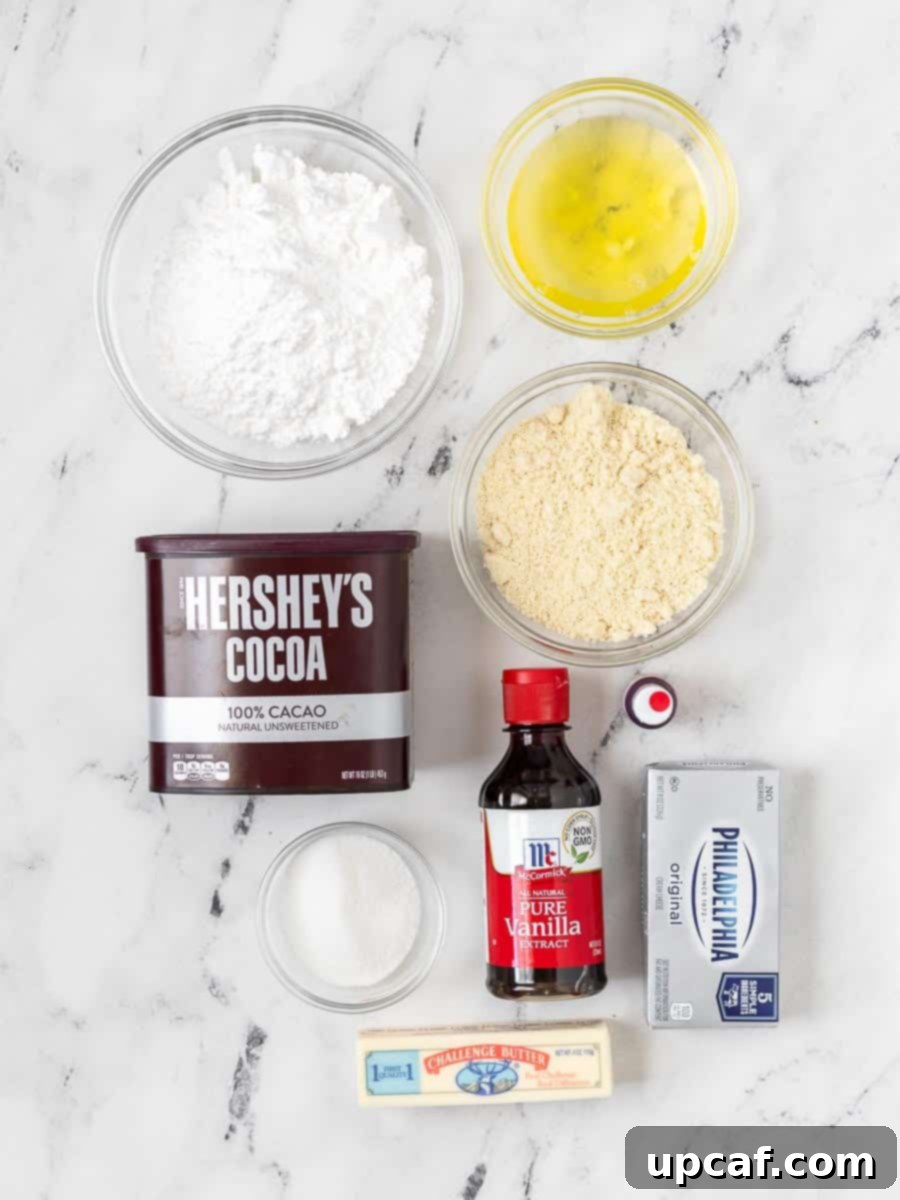
For the French Macaron Shells:
- Powdered Sugar: Also known as confectioners’ sugar or icing sugar. Its fine texture is absolutely critical for smooth macaron shells. Granulated sugar will not dissolve properly and will result in grainy, lumpy shells. Ensure it’s fresh and lump-free, sifting is a must!
- Almond Flour: This is the backbone of any French macaron. You *must* use blanched, super-fine almond flour, not almond meal. Almond meal includes the skin and is coarser, which will prevent your macarons from achieving their signature smooth texture and delicate “feet.” Finely ground almond flour contributes to the unique taste and tender chewiness.
- Cocoa Powder: Essential for both the iconic red velvet color and its subtle chocolate flavor. For the best depth of color and taste, opt for Dutch-processed cocoa powder. It’s less acidic than natural cocoa, resulting in a richer, darker hue when combined with red food coloring, which is crucial for achieving that authentic red velvet look.
- Egg Whites: Room temperature egg whites are non-negotiable for a stable meringue. Older, room-temperature egg whites whip up more easily and hold their structure better. Crucially, ensure there is absolutely no trace of egg yolk, as any fat will prevent the egg whites from whipping into stiff peaks.
- Granulated Sugar: This provides structure and stability to the meringue, contributing to the crispness and chewiness of the shells. Using fine granulated sugar is recommended as it dissolves more readily into the egg whites, preventing a gritty texture.
- Red Food Coloring: To achieve that vibrant, unmistakable red velvet shade, use high-quality gel food coloring. Liquid food coloring can introduce too much moisture, throwing off the delicate balance of your macaron batter. You can adjust the amount to get your desired intensity of red or even a lovely deep pink.
For the Cream Cheese Filling:
- Cream Cheese: Softened to room temperature, full-fat cream cheese is ideal for a rich, creamy, and spreadable filling. Cold cream cheese will result in a lumpy filling.
- Unsalted Butter: Softened to room temperature, unsalted butter allows you to control the overall saltiness of your filling. It provides structure and richness, making the filling wonderfully smooth and decadent.
- Vanilla Extract: Pure vanilla extract is key here. Its warm, aromatic notes elevate the flavor profile of the cream cheese filling, complementing the subtle cocoa in the macaron shells and truly bringing out that classic red velvet taste. Avoid imitation vanilla for the best results.
- Powdered Sugar: Once again, powdered sugar is chosen for its ability to dissolve completely, ensuring a perfectly smooth and lump-free cream cheese filling that’s easy to pipe and delightful to eat. Sifting it before use is highly recommended to prevent any textural inconsistencies.
How to Make Show-Stopping Red Velvet Macarons
Baking macarons can feel like an art, but with patience and precise execution, you can achieve beautiful results every time. Follow these detailed steps to create your perfect Red Velvet French Macarons.
Crafting the Perfect Red Velvet Macaron Shells
- Prepare Your Baking Arena: Start by preheating your oven to precisely 300°F (150°C). Line several baking sheets with either silicone baking mats (like Silpat) or high-quality parchment paper. Silicone mats are often preferred for their non-stick properties and even heat distribution, which helps in achieving consistent macaron “feet.” If using parchment, ensure it lies flat or use a tiny dab of batter under each corner to prevent curling. Prepare macaron templates if you wish to ensure uniform sizes.
- Master the Dry Mix: In the bowl of a food processor, combine the powdered sugar, almond flour, and cocoa powder. Pulse briefly until the mixture is incredibly fine and fully combined, with no visible lumps. This step is crucial for achieving smooth macaron shells. If you don’t have a food processor, carefully sift these ingredients together at least twice into a large bowl. Don’t skip the sifting, as even tiny lumps can cause imperfections in your finished shells. Set this perfectly combined dry mixture aside.
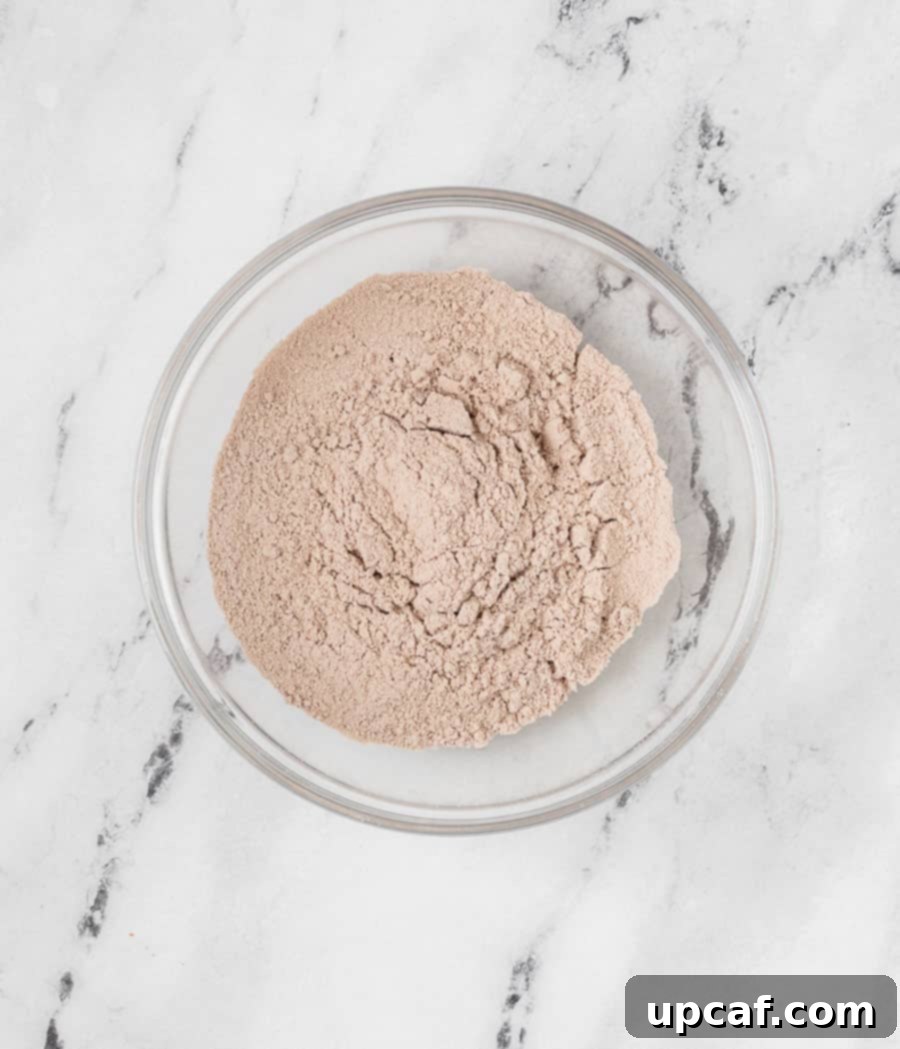
- Whip Up the Meringue Magic: In a separate, impeccably clean medium bowl (preferably metal or glass, as plastic can retain grease), begin beating the room-temperature egg whites on low speed. Once they start to get foamy and resemble soft bubbles, slowly begin adding the granulated sugar, a tablespoon at a time. Gradually increase the speed to medium-high. Continue beating until the mixture thickens and forms soft peaks. At this stage, add your chosen red food gel coloring. Keep beating until stiff, glossy peaks form. When you lift the whisk, the meringue should hold its shape firmly without drooping, and the mixture should be shiny and smooth.
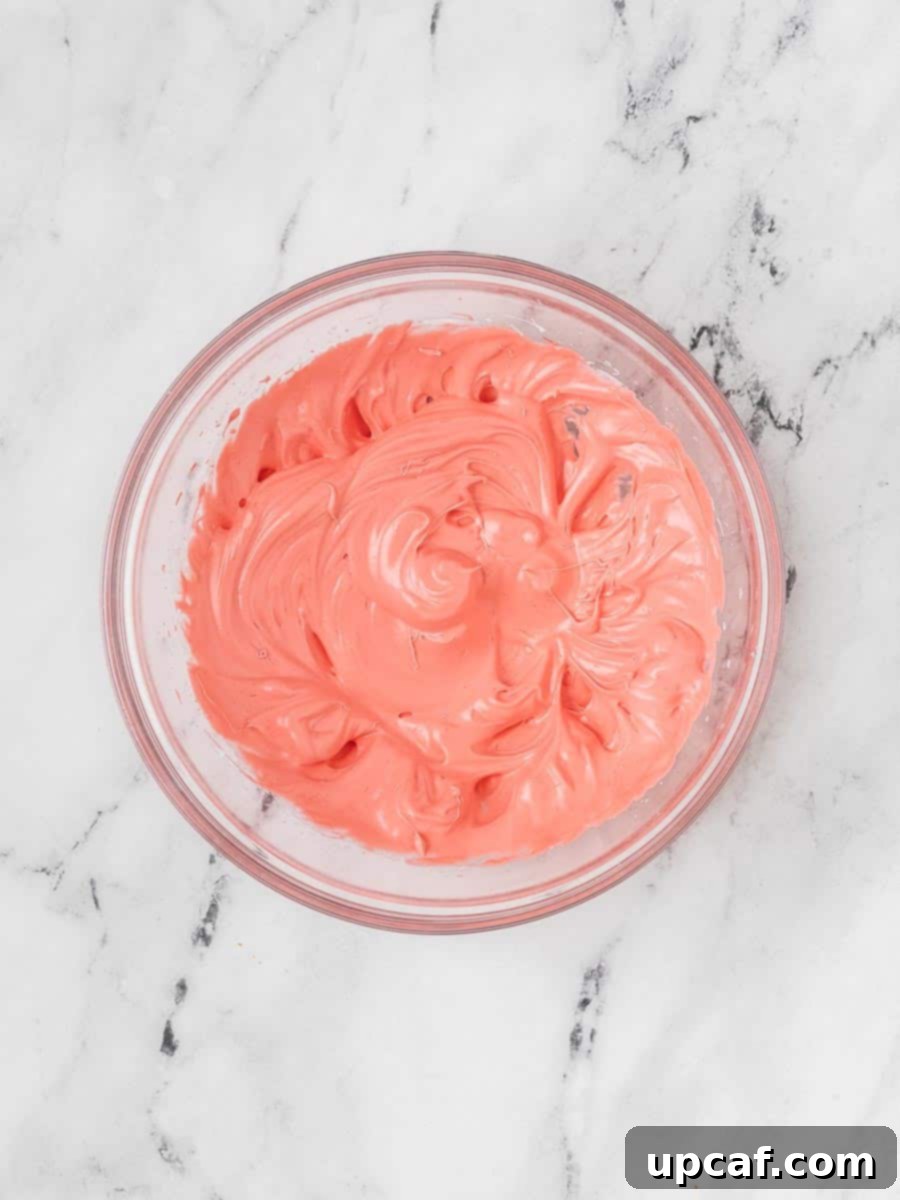
- The Art of Macaronage: This is arguably the most critical step. Gently add the stiff meringue into the bowl with your sifted dry ingredients. Using a silicone spatula, begin to fold the two mixtures together. The technique, known as macaronage, involves scraping the sides of the bowl and folding the batter over itself, then pressing it against the side of the bowl to deflate some air. Continue this gentle folding until the batter reaches the “lava-like” consistency, where it flows off your spatula in a thick, continuous ribbon. When you lift the spatula and draw a figure-8 with the falling batter, it should hold its shape for a few seconds before slowly melting back into the rest of the mixture. Be careful not to under-mix (leading to cracked shells) or over-mix (leading to flat, spreading shells without feet).
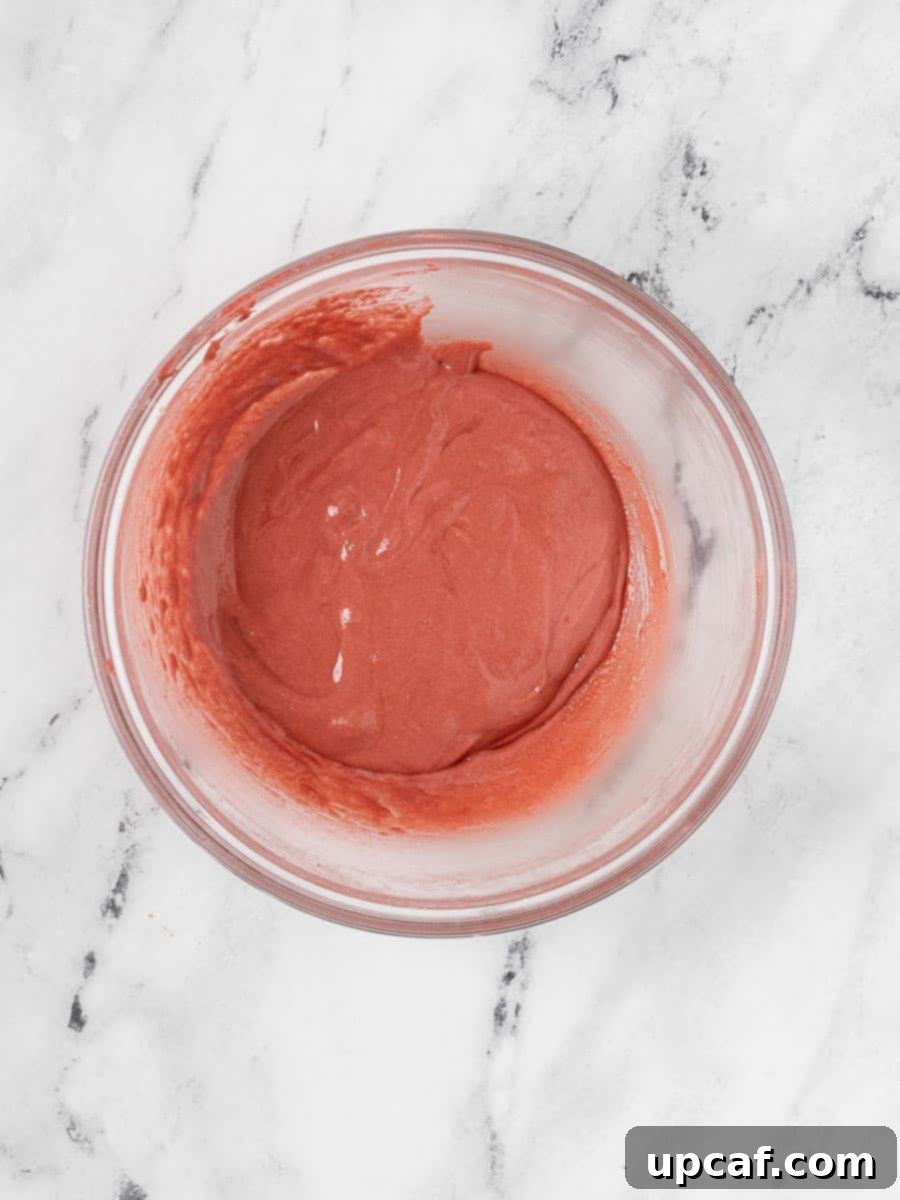
- Pipe with Precision: Transfer the perfectly mixed macaron batter into a large piping bag fitted with a round piping tip (a Wilton #12 tip is often recommended for 1-inch shells). Hold the piping bag perpendicular to your baking sheet and pipe uniform 1-inch disks onto the prepared mat or parchment. Aim for consistent size and spacing to ensure even baking.
- Evacuate Air Bubbles: Once all shells are piped, firmly tap the baking sheet against your counter 5 or 6 times. This forces any trapped air bubbles to rise to the surface. Use a toothpick or a scribe tool to gently pop any remaining visible bubbles. This step is crucial for achieving smooth, unblemished macaron tops.
- The Crucial Resting Phase (Crotage): Allow the piped macarons to rest at room temperature for at least 60 minutes, or longer depending on your kitchen’s humidity. This resting period, also known as “crotage,” allows a thin skin to form on the surface of the shells. To test for readiness, gently touch the surface of a macaron; your finger should come away clean, with no batter sticking to it. This “skin” is what forces the air to escape from the bottom during baking, creating the characteristic “feet.”
- Bake to Perfection: Place the baking sheet on the center rack of your preheated oven. Bake for approximately 13-15 minutes. To ensure even baking and coloring, rotate the pan halfway through the baking time (around the 7-8 minute mark).
- NOTE: Test for Doneness: To check if your macarons are baked through, gently touch the edge of a macaron shell and try to wiggle it. If it feels stable and doesn’t wobble or slide, it’s done. If it still feels loose, bake for an additional 1-2 minutes, checking frequently. Over-baking can lead to dry, brittle shells, while under-baking results in sticky, hollow shells.
- Cool Down Patiently: Once baked, remove the macarons from the oven and slide the entire baking mat or parchment paper onto a wire cooling rack. Allow them to cool completely on the sheet before attempting to peel them off. Trying to remove them while warm will likely result in broken shells. Once cool, gently peel each macaron shell from the mat and match them up with similarly sized companions, ready for their delicious filling.
Whipping Up the Cream Cheese Filling
The luscious cream cheese filling is what truly transforms these macarons into a red velvet dream.
- Creamy Base: In the bowl of a stand mixer fitted with a paddle attachment (or using a hand mixer), beat the softened cream cheese and unsalted butter together on medium speed. Continue mixing until the mixture is exceptionally soft, smooth, and completely creamy, with no lumps remaining. This might take 2-3 minutes.
- Flavor & Sweetness Infusion: Add the pure vanilla extract to the cream cheese mixture. Then, add about half of the powdered sugar. Beat on low speed until the sugar is fully incorporated and the mixture is smooth again.
- Achieve Fluffy Perfection: Scrape down the sides of the bowl. Add the remaining powdered sugar and beat on medium-high speed for another 5-6 minutes. This extended beating incorporates air, making the buttercream light, fluffy, and beautifully pipeable. The filling should be smooth, airy, and hold its shape.
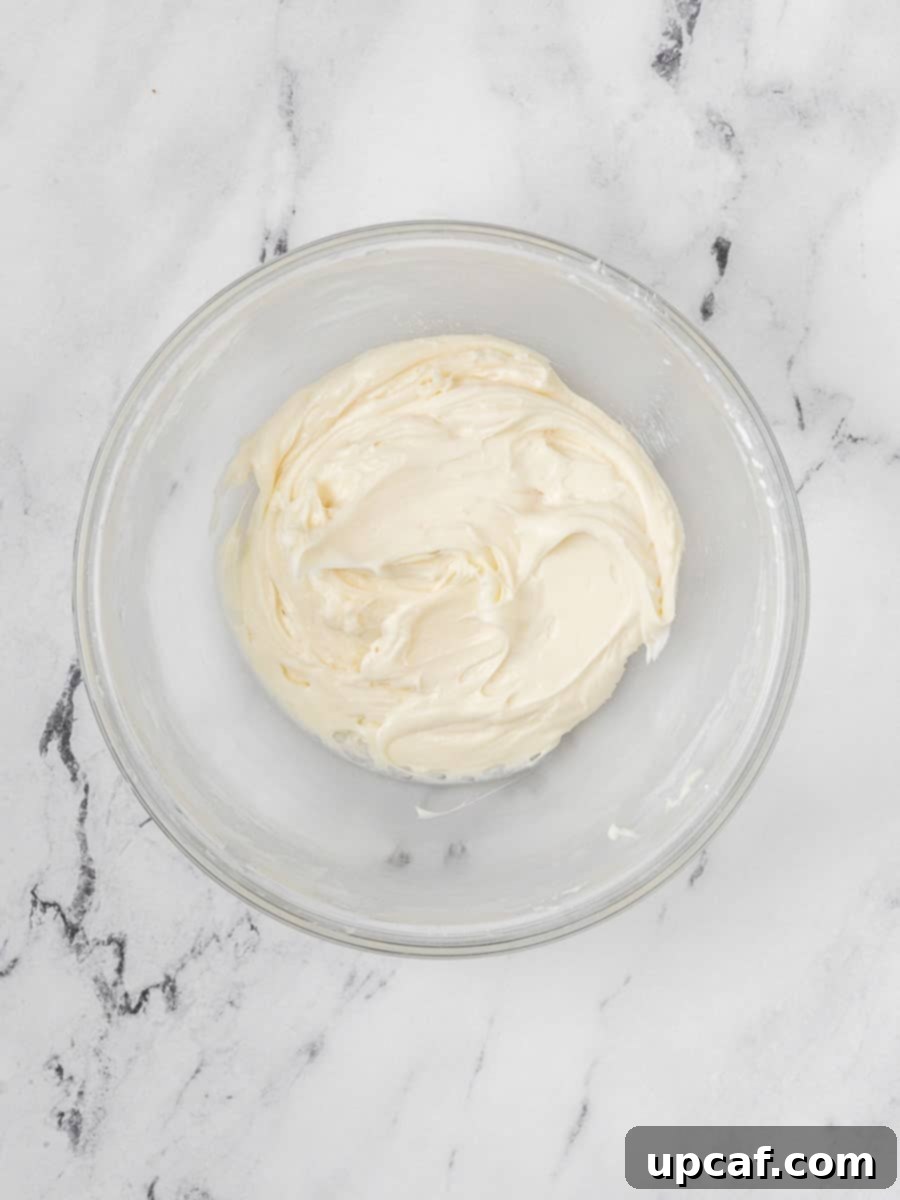
- Assemble Your Masterpiece: Transfer the finished cream cheese buttercream into a piping bag fitted with your preferred piping tip (a round or star tip works well). Take one cooled macaron shell, pipe a generous dollop of filling onto the flat side, and then gently place another similarly sized shell on top. Apply light pressure to create a perfect sandwich.

Common Macaron Challenges & Solutions
Macarons are notorious for being a bit finicky, but understanding common issues can help you troubleshoot and achieve perfect results. Don’t be discouraged if your first batch isn’t flawless – practice truly makes perfect with these delicate cookies!
Why Don’t My Macarons Have Feet?
The iconic ruffled “feet” are a hallmark of a well-made French macaron. If your shells emerge from the oven without them, it’s often due to two primary culprits:
- Over-mixing the Batter (Macaronage): If you fold the macaron batter too much, you deflate too much air from the meringue. This results in a batter that is too runny and spreads excessively on the baking sheet, preventing it from rising properly to form feet. The batter needs just enough air to expand and lift. Remember the “figure 8” test: the batter should flow off the spatula in a thick ribbon and form a “figure 8” that holds its shape for a few seconds before melting back into the mass.
- Insufficient Resting Time (Crotage): The resting period is absolutely crucial. During this time, a thin, dry skin forms on the surface of the piped shells. This skin acts as a barrier, forcing the expanding air inside the macaron to escape from the bottom, thus creating the characteristic “feet.” If the shells are not rested long enough, this skin won’t fully form, and the air will burst through the top, leading to cracked shells or shells without feet. The time required for resting can vary significantly based on your kitchen’s humidity. Always perform the finger test: gently touch a shell, and if no batter sticks to your finger, they are ready to bake. If your kitchen is particularly humid, consider using a fan to aid the drying process.
Why Are My Macarons Cracked?
Cracked macaron shells are another common frustration, often pointing to issues with batter consistency or baking environment:
- Under-mixing the Batter: Paradoxically, under-mixing can also cause cracked shells. If the batter isn’t mixed enough, it retains too much air. During baking, this excessive air rapidly expands and has no controlled escape route (because the “skin” on top isn’t strong enough or the air pressure is too high), causing the shells to crack open. Ensure your macaronage is complete, and the batter flows like a thick ribbon.
- Oven Temperature Too High: An oven that’s too hot can cause the macaron shells to rise too quickly and crack before the outer skin has a chance to set properly. Always use an oven thermometer to verify your oven’s temperature, as built-in thermostats can be inaccurate.
- Insufficient Resting Time: As mentioned above, if the shells don’t form a proper skin during resting, the air can burst through the top instead of creating feet, leading to cracks.
Other Common Macaron Issues:
- Hollow Shells: Often a result of over-beating the meringue or baking at too low a temperature, which causes the macarons to rise too quickly and then collapse, leaving a void.
- Lopsided Feet: Uneven heat distribution in the oven, or piping on an uneven surface, can lead to feet that only form on one side. Rotating the baking sheet during baking helps.
- Sticky Bottoms: This usually means the macarons were under-baked. They need a full cool-down period before attempting to remove them from the mat. If they’re sticky even after cooling, they likely need another minute or two in the oven next time.
Decoding Macaronage: The Key to Perfect Shells
Macaronage is the French term for the critical mixing technique used to combine the meringue with the dry ingredients (almond flour and powdered sugar) to create the macaron batter. It’s the step that determines the texture and appearance of your finished macaron shells.
The goal of macaronage is to achieve a batter consistency that is smooth, shiny, and flows just right – not too thick, not too thin. This is often referred to as “lava-like” or “ribbon stage.” The most widely used technique to correctly identify this stage is the “figure 8” test: when you lift your spatula and let the batter fall back into the bowl, it should flow continuously like a thick ribbon, allowing you to draw a figure 8 without it breaking. Once drawn, this figure 8 should slowly, but not immediately, melt back into the rest of the batter, typically taking 10-20 seconds to completely disappear.
Mastering macaronage is paramount. When this step is executed correctly, there is an incredibly high chance that your macarons will turn out perfectly, boasting beautiful, well-formed “feet,” a wonderfully fluffy yet chewy texture, and smooth, shiny shells. Over-mixing will deflate too much air, leading to flat, spreading shells without feet. Under-mixing will leave too much air, causing cracked or hollow shells. It truly is the heart of macaron making!
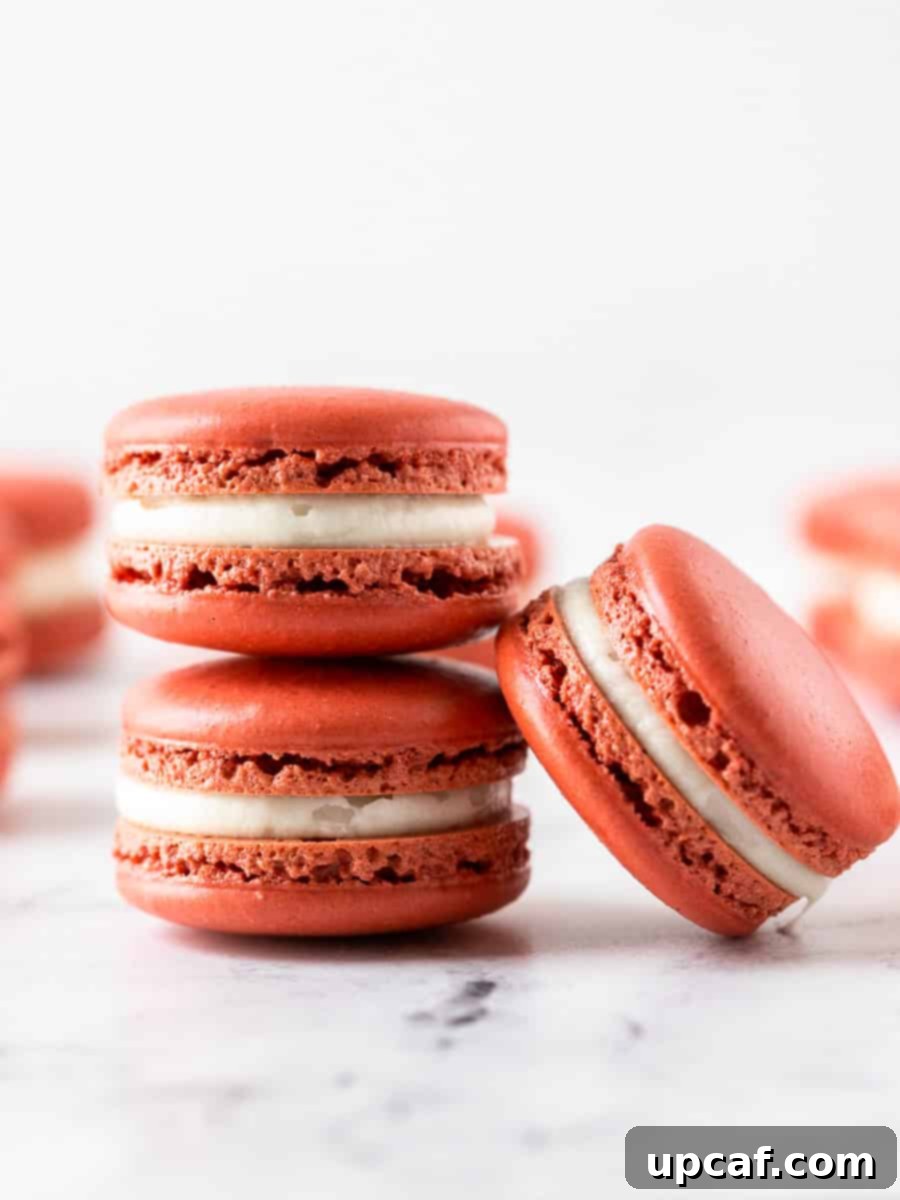
Expert Tips for the Best Macaron Recipe
Achieving macaron perfection can be a journey, but these invaluable tips will guide you to consistently stunning results:
- Perfect Batter Consistency is Key: As highlighted in the macaronage section, the batter’s consistency is paramount. It should be fully combined, smooth, and streaky-free. The “lava-like” ribbon test or “figure 8” test is your best indicator. When the batter slowly flows off the spatula in a thick, continuous ribbon, holding its shape for several seconds before merging back into the mass, it’s ready. Avoid over-mixing, which leads to runny batter and flat shells, or under-mixing, which causes cracked shells.
- Accelerate Resting with a Fan: If your kitchen is humid or you’re short on time, strategically placing a fan nearby can significantly speed up the drying process of your macaron shells. This helps form that crucial dry skin (crotage) more quickly, ensuring better feet development. Just make sure the fan isn’t too strong, which could distort the piped shapes.
- Gel Food Coloring is Your Friend: For vibrant colors like the signature red velvet, always opt for high-quality gel food coloring. Liquid food coloring introduces excess moisture into the batter, which can disrupt the delicate wet-to-dry ingredient ratio and negatively impact the macaron’s structure. Gel colors are concentrated and won’t thin out your batter.
- Sifting: The Non-Negotiable Step: Macarons demand a flawlessly smooth batter, free from any lumps. Sifting your powdered sugar, almond flour, and cocoa powder (preferably twice) is a crucial step. Lumps can lead to uneven textures, bumpy shells, and the temptation to over-mix the batter, which can result in cracked or hollow shells.
- Choose the Right Piping Tip: For uniformly shaped macaron shells, a round piping tip is essential. Wilton’s Round Decorating Piping Tip #12 is an excellent choice for piping 1-inch diameter shells. Consistency in piping size contributes to even baking.
- Practice Patience with Maturing: French macarons are best enjoyed after a period of “maturing” in the refrigerator. Waiting at least 12-24 hours after filling allows the flavors to meld and the filling’s moisture to soften the shells slightly, resulting in that perfectly chewy, melt-in-your-mouth texture that macarons are famous for.
- Optimal Storage for Freshness: To maintain their delicate texture and fresh taste, store filled macarons in an airtight container in the refrigerator at all times. They will remain fresh for up to a week. While still delicious, they may lose some of their initial crispness over time, so enjoying them sooner is always recommended for the ultimate experience.
- Utilize an Oven Thermometer: Oven temperatures can fluctuate wildly and built-in thermometers are often inaccurate. An inexpensive oven thermometer placed inside your oven provides an accurate reading, ensuring your macarons bake at the precise temperature required for perfect feet and consistent results.
- Cleanliness is Next to Macaronness: Ensure all your mixing bowls and utensils, especially those used for whipping egg whites, are spotlessly clean and free from any grease or oil residue. Even a tiny amount of fat can prevent egg whites from whipping up properly, leading to a failed meringue.
- Measure by Weight: For macaron recipes, precision is key. Whenever possible, measure your ingredients by weight using a kitchen scale rather than volume. This eliminates discrepancies and ensures the exact ratios are maintained, leading to more consistent and successful batches.
Frequently Asked Questions About Red Velvet Macarons
Achieving uniformly sized macaron shells is a key to professional-looking results. One of the easiest methods is to use silicone baking mats that have pre-printed macaron circles. Alternatively, you can print a macaron template from online sources, slide it under your parchment paper, and pipe directly over the guides (remember to remove the template before baking!). Crucially, hold your piping bag straight down, perpendicular to the baking sheet, rather than at an angle. Apply consistent pressure, pipe until the batter just fills the circle, then release pressure and swiftly lift the bag straight up. Practice will make perfect!
Cracked macaron shells are often a sign of either under-mixed batter or an oven that’s too hot. If your batter is under-mixed during macaronage, it retains too much air. During baking, this trapped air expands rapidly and bursts through the top surface, causing cracks. Ensure your batter passes the “figure 8” test, flowing off the spatula in a thick, continuous ribbon. Additionally, an oven that’s running too hot can cause the shells to set too quickly on the outside before the internal air has had a chance to escape properly, leading to cracks. Always use an oven thermometer to verify your oven’s temperature.
Absolutely! Adding toppings can elevate their visual appeal and sometimes add extra texture. If you want to add sprinkles, apply them immediately after piping the shells and before the resting period. Nonpareil sprinkles are often preferred for macarons as they are small and don’t weigh down the delicate shells. Another popular option is to drizzle melted white chocolate over the tops of the shells after they have baked and cooled completely, adding a beautiful contrast and an extra layer of sweetness.
To keep your French macarons fresh and delicious, always store them in an airtight container in the refrigerator. This helps maintain their delicate texture and prevents them from drying out or absorbing external odors. While they are still delightful, they are best enjoyed within one week of assembly. Over time, the shells will soften, potentially losing some of that initial crunch, so savor them as soon as possible for the optimal experience!
Yes, macarons freeze beautifully! For best results, allow filled macarons to “mature” in the fridge for 24-48 hours first to let the flavors meld. Then, transfer them to a freezer-safe airtight container, separating layers with parchment paper, and freeze for up to one month. When you’re ready to enjoy them, simply thaw the macarons in the refrigerator for a few hours before bringing them to room temperature for serving. You can also freeze un-filled shells. Thaw the shells in the fridge, then bring to room temperature before piping with fresh filling.
The secret to achieving that rich, deep, and bright red velvet color in your macaron shells lies in using a strategic combination of cocoa powder and high-quality red food gel coloring. Using red food coloring alone will often result in a pinkish hue. The cocoa powder adds a reddish-brown base, which, when combined with concentrated red food gel, creates the distinctive, vibrant, and deep red velvet shade you’re looking for. Make sure to use gel coloring, as liquid coloring can dilute your batter.
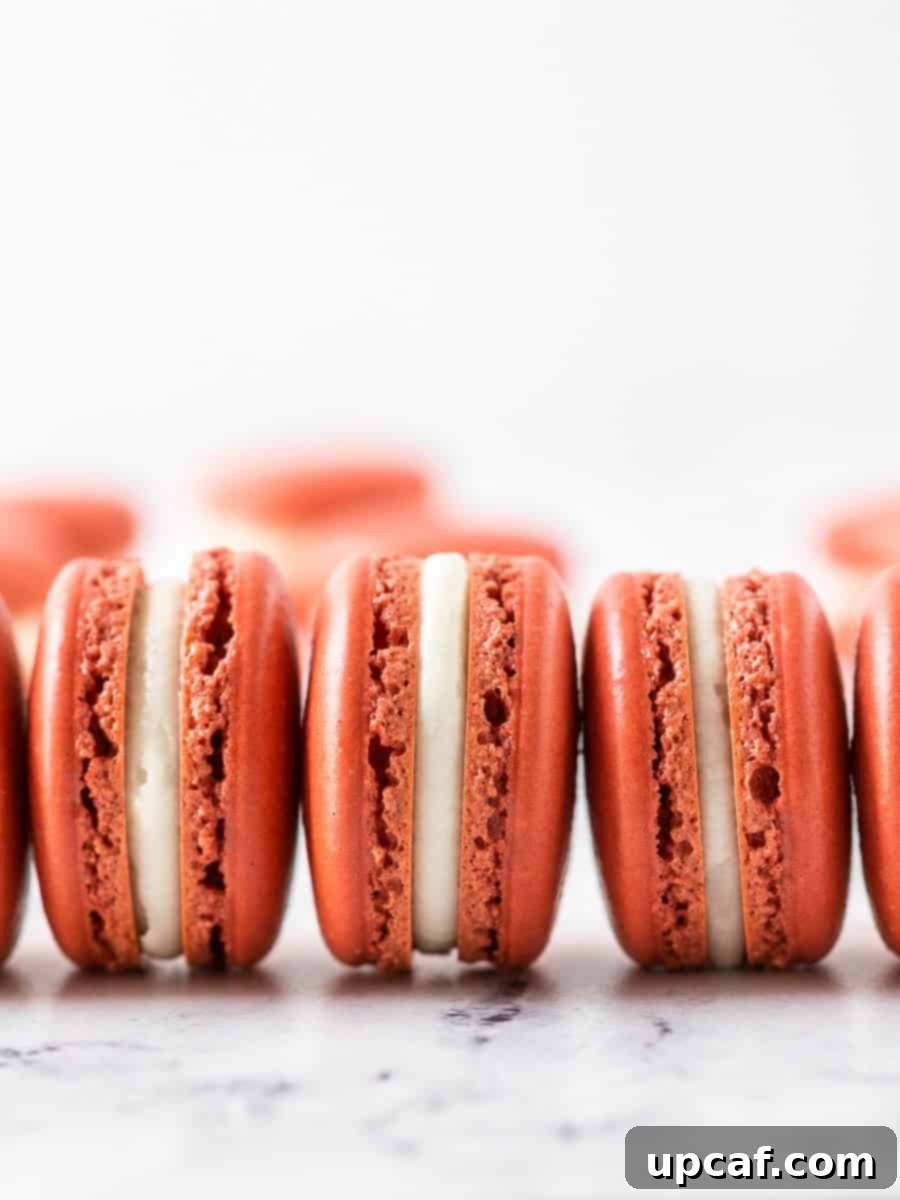
More Irresistible Desserts To Try
If you’ve fallen in love with baking after making these delightful Red Velvet French Macarons, or simply crave more sweet adventures, explore these other fantastic recipes:
- Lemon French Madeleines Cakes: Delicate, shell-shaped sponge cakes with a zesty lemon flavor, perfect for an elegant tea time.
- Strawberry Jam Linzer Cookies: Beautiful, crumbly shortbread cookies filled with sweet strawberry jam, a festive treat for any season.
- Cheesecake Brownie Fudge Bars: A decadent fusion of rich, fudgy brownies swirled with creamy cheesecake, offering the best of both worlds.
- Chocolate Chip Cheesecake: A classic, creamy cheesecake studded with delectable chocolate chips, a crowd-pleasing dessert that’s always a hit.
- Coconut Cheesecake Bars: Tropical and rich, these bars feature a creamy coconut cheesecake filling on a delightful crust, perfect for a taste of paradise.
I genuinely hope you enjoy exploring all the wonderful recipes I share with you, especially this truly delicious Red Velvet French Macarons recipe. There’s immense joy in creating something so beautiful and tasty from scratch. I encourage you to try it, savor every bite, and share your delightful creations with your friends and family!
If you try this recipe and love it, please take a moment to leave a star rating and a comment below. Your feedback helps me and other bakers! Also, don’t forget to use my hashtag to share your delicious recreations with me on Instagram so I can see and celebrate your baking success! Follow me at Cookin’ With Mima on FACEBOOK | INSTAGRAM | PINTEREST for all of my latest social posts, kitchen tips, and mouth-watering recipes. Happy baking!
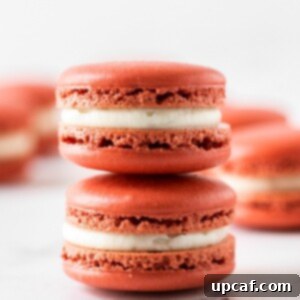
Red Velvet French Macarons
Ingredients
For the Shells:
- 1⅔ cup powdered sugar
- 1 cup almond flour
- 1 tablespoon cocoa powder
- 3 large egg whites
- ¼ cup granulated sugar
- 1-2 drops red food gel coloring
For the Filling:
- 4 oz cream cheese, softened
- ½ stick unsalted butter, softened
- 1 teaspoon pure vanilla extract
- 1½ cups powdered sugar
Instructions
- Preheat your oven to 300 F°
For the Shells:
- Line a baking sheet with a silicone baking mat or parchment paper.
- Use a food processor to pulse the powdered sugar, almond flour, and cocoa powder until fully combined and rid of lumps. Sift the combined ingredients into a large bowl. If you do not have a food processor you can just sift the ingredients together. Set aside
- In a medium bowl, beat the egg whites on low speed until they start to get foamy. Slowly add the granulated sugar and increase the speed. Add the red food coloring. Beat the mixture until stiff peaks form.
- Add the meringue into the dry ingredients and use a silicone spatula to gently fold the two together. The batter should be fully combined and not streaky. The batter is ready when it falls off of the spatula in a thick ribbon. It should not be too runny.
- Transfer the mixture to a piping bag fitted with a piping tip. Pipe about 1-inch disks onto the prepared baking sheet.
- Firmly tap the baking sheet 5 or 6 times on the counter to bring any air bubbles to the surface. Use a toothpick to pop any remaining bubbles.
- Let the macarons rest for at least 1 hour. You should be able to gently run your finger over the surface of the macarons without any getting on your finger.
- Place the baking sheet on the center rack of the oven and bake for 15 minutes, rotate the pan every 5 minutes to ensure even baking and coloring.
- NOTE: Test for doneness: touch a macaron lightly and try to move it. If it slides and wobbles, bake it for 1-2 minutes longer.
- Remove the macarons from the oven and allow to cool completely on the baking sheet.
- Gently peel each cooled macaron off of the mat and match up with a similarly sized cookie.
For the Filling:
- Using a stand mixer fitted with a paddle attachment or a hand mixer, beat the cream cheese and butter until it is very soft and creamy.
- Add the vanilla and half of the powdered sugar and beat until fully combined and smooth.
- Add the rest of the powdered sugar and beat for 5-6 minutes or until the buttercream is fluffy.
- Place the buttercream in a piping bag and pipe your desired amount on to the side of one cookie. Place another cookie on top.
Notes
- When mixing the French macaron batter, the batter should be fully combined and not streaky. The batter is ready when it falls off of the spatula in a thick ribbon. It should not be too runny.
- If your shells are taking too long to set, you can place a fan nearby to get them to set faster.
- Only use gel food coloring for macarons, as liquid food coloring may mess up the wet to dry ingredients ratio.
- Macarons are delicate and you don’t want any lumps in your batter. Sifting the dry ingredients is a crucial step. If you have lumps in your batter, you might be tempted to continue to mix your batter, causing it to be over-mixed and yield cracked shells.
- Use a round tip to pipe the shells, preferably Wilton’s Round Decorating Piping Tip #12.
- French macarons are best eaten after they are mature. Wait at least 12 hours after filling them to serve.
- Macarons are best kept in the fridge at all times to remain fresh and last longer.
Nutrition
Like this recipe? Rate and comment below!
